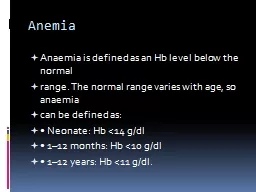

range The normal range varies with age so anaemia can be defined as Neonate Hb lt14 gdl 112 months Hb lt10 gdl 112 years Hb lt11 gdl Physiologic Anemia of the Newborn ID: 908642
Download Presentation The PPT/PDF document "Anemia Anaemia is defined as an Hb level..." is the property of its rightful owner. Permission is granted to download and print the materials on this web site for personal, non-commercial use only, and to display it on your personal computer provided you do not modify the materials and that you retain all copyright notices contained in the materials. By downloading content from our website, you accept the terms of this agreement.
Slide1
Anemia
Anaemia is defined as an Hb level below the normal
range. The normal range varies with age, so anaemia
can be defined as:
• Neonate: Hb <14 g/dl
• 1–12 months: Hb <10 g/dl
• 1–12 years: Hb <11 g/dl.
Slide2Physiologic Anemia of the Newborn
At one week postnatal all RBC indices begin declining to a minimum value reached at about 2 months of age.
decreased RBC production
plasma dilution associated with increasing blood volume
shorter life span on neonatal RBCs (50-70 days)
more fragile RBCs
switch from HbF to HbA
HbF decreases about 3% per week
at 6 mo. HbF represents only 2% of total Hb
switch to HbA provides for greater unloading of oxygen to tissues d/t lower oxygen affinity of HbA relative to HbF.
seldom produces symptoms
not altered by nutritional supplements
Slide3Anemia of Prematurity
Occurs in low birth weight infants w/ poor erythropoietin response
Protein content of breast milk may not be sufficient for hematopoiesis in the premature infant.
Hb level rapidly declines after birth to a low of 7-10 g/dl at 6 weeks of age.
Signs and Symptoms
apnea
poor weight gain
pallor
decreased activity
tachycardia
Slide4Slide5Slide6Slide7Slide8Slide9Slide10Slide11Slide12Slide13Slide14Fe++
deficiency
Tx–
Fe
++
replacement gives dramatic response
reticulocytosis in 72 hr, Hgb responds at ~1g/L per wk, iron stores us. replenished by 3 mo
Slide15Slide16Slide17Slide18Slide19Slide20Slide21Slide22Slide23Slide24Slide25Slide26Slide27Slide28Slide29Slide30Slide31Slide32Slide33Slide34Slide35Slide36Beta Thalassemia Major
No production of Beta chains- Chromosome 11
Autosomal recessive
25 % chance with each pregnancy
Pre-natal testing for carriers
Chorionic villous sampling for diagnosis
Transfusion dependent-allows for normal development
Pen Prophylaxis, Anti oxidants
Splenectomy after age 5
Iron overload- inherent and transfusion
Need chelators
BMT is a cure
Slide37Slide38Slide39Management
Blood transfusion
lifelong monthly transfusions of red blood cells.
Keep
Hb
anove
10 g/dl.
iron
chelation
with subcutaneous
desferrioxamine
, or with an oral iron
chelator
drug, such as
deferasirox
, starting from 2 to 3 years of age.
Patients who comply well with transfusion and
chelation
have a 90% chance of living into their forties
Bone marrow transplantation,
which is currently the only cure. It is generally reserved for children with an
HLAidentical
sibling as there is then a 90–95% chance of success (i.e. transfusion independence and long-term cure) but a 5% chance of transplant-related
mortality.